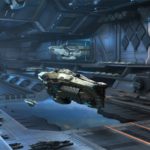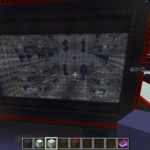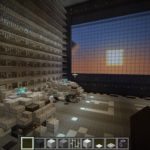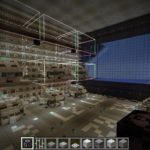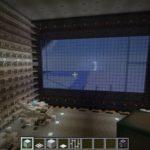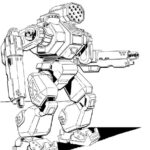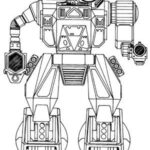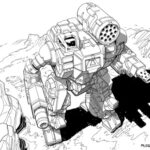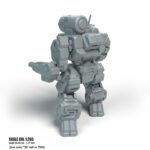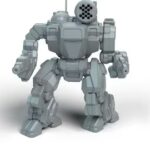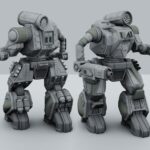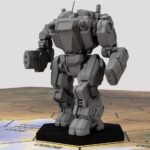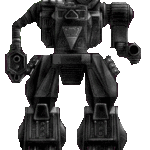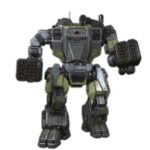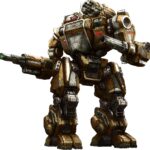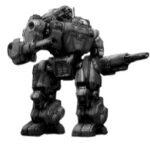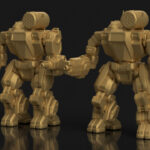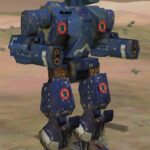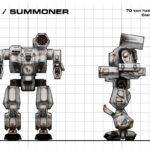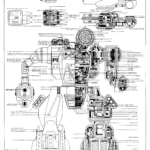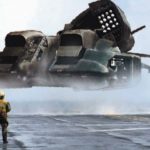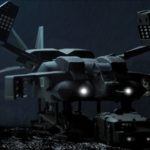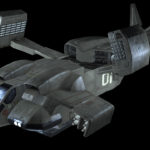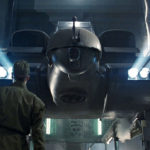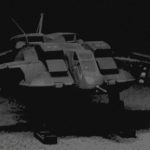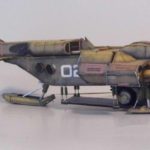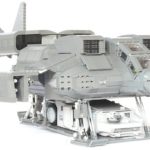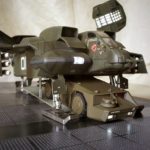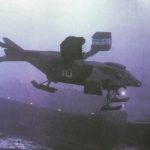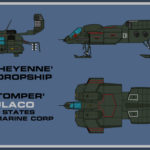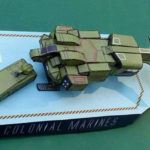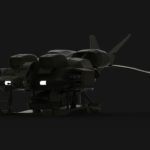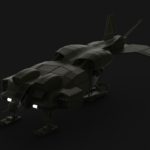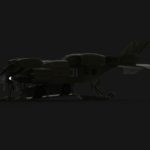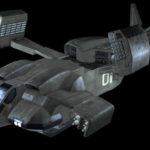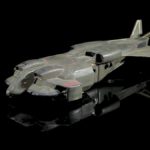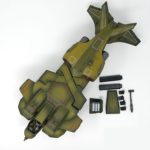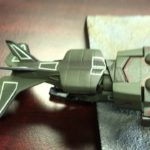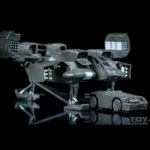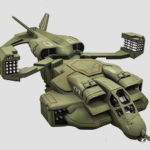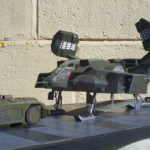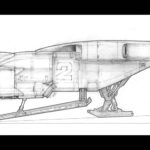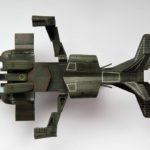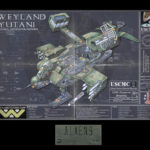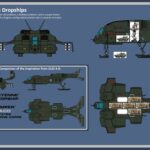This is the size capable of comfortably housing Persephone.
–
Table of Contents:
- Introduction
- Number & Locations
- Dimensions
- Personnel
- Contents
- Access
- Conceptual Images
- 2022 Update: Minecraft Scale-model
- 2023 Update: The Mechs
- 2023 Update 2: The Dropships
- 2023 Update 3: Persephone in One
–
Introduction:
The largest hangars built into TNH are capable of housing full-sized cargo planes, and are usually reserved for spacecraft larger than shuttles. When a ship is big enough to transport an entire platoon and all their gear, it will be directed to one of these large hangars. Large cargo shipments are also commonly staged here, especially when coming from ships too big to enter a TNH hangar; when other vast ships pull up alongside and dock with TNH, they unload into TNH’s large hangars.
–
Number & Locations:
TNH has 3 of these large hangars on each of its sides; 6 total. Each set of 3 is lined up along the middle of one side of the ship. Their bay doors open out to the left or right side of TNH.
6 large hangars, each with 6 large floor side landing lads, 1 pad reserved for staging, thus room for 5 dropships per large hangar; 30 dropships in TNH
…
2 Thor mechs and 5 LAVs in each dropship; 60 Thors and 150 LAVs in TNH
…
1 Marine in each Thor, and 5-7 in each LAV = 60 Thor operators, and 750-1,050 LAV scouts
…
With only 1,200 Marines in the detachment in TNH, the majority are often part of a dropship team, or at least almost always deploy via these dropships, though they can also use shuttles and other craft smaller than TNH dropships.
–
Dimensions:
Each large hangar of TNH is dozens of stories tall; >300′.
They are ~400′ wide, and ~400′ deep (into the sides of TNH).
This gives each of TNH’s large hangars are floorspace of 160,000 square-feet, and a volume of 48,000,000 cubic-feet.
35x14x14h blocks in the model x3scale (each block = not 3’^3 but 9’^3) = 315’Dx126’Wx126’H (maneuvering/entry/exit/taxiing room between the landing pads and balconies)
2023 September re-calculation/check: ~390’Dx380’Wx280’H (because it is not 1:3 scale, but 1 block = 10′)
–
Personnel:
There are usually ~100 crew members working in each of these large hangars at any time. Most are on/in the Spacecraft docked and anchored/tethered in here. Several are in each hangar’s Air Traffic Control-tower (ATC). A few will be driving (or hovering Spacecraft) around.
- ~100 total: ~51/+ as pilots, copilots, other crew, and passengers
- ~7 in the “tower”
- Red (ordnance, EOD): ~6
- Orange ~6
- Yellow ~3
- Green ~3
- Blue ~4
- Purple ~6
- Brown ~3
- White ~3
- White-and-red-plus-sign ~3
- Silver ~3
–
Contents:
The dropships stored in these hangars are TNH’s equivalent of MAC cargo planes, just with their own weapons/defenses now.
The “Thor” BattleMechs are kept inside these large hangars, as are the large human-piloted dropships that can help carry/deploy them planet-side. “Thors” stand a few stories tall (~30’+), and their dropships are roughly 1-2 stories taller than them (~50’+). Their (a “Thor” BattleMech’s) “footprint” is a ~5’x10′ area (50 square-feet), with their shuttle/dropship footprints being ~30’x100′ (3,000 square-feet); each large hangar of TNH can house/store 5 of those Spacecraft with all of the 2 “Thors” each of them can carry. (TNH has 30 of these Spacecraft, thus 60 of the “Thors”.)
LAVs and Thors sometimes get kept clamped down in their dropships, ready to deploy at a moment’s notice, especially those on QRF, but the Thors can be clamped to any landing pad, or moved to the intermediate or small hangars, and the LAVs can be moved into the garage-like in-wall/hangar storage units, as well as the other (smaller) hangars.
–
Access:
Only TNH personnel (active-duty military, Inisfreeans, and contractors stationed aboard this ship) can enter these hangars, and only when they are assigned to work a shift in any of them. This includes when they are tasked with deploying from one of these hangars, such as via piloting one of the dropships out of them. All others require one of those approved personnel as their escort.
–
Conceptual Images:
–
2022 Update: Minecraft Scale-model
The large-hangar scale-model screenshots show 18 dropships in each large hangar, but those other 13 landing pads are used for smaller craft, such as resupply shuttles/barges, contractor vessels, and confiscated/commandeered craft.
The open space between landing pads is not luxurious or excessive/unused/wasted; it is so multiple craft can maneuver/taxi simultaneously, even if one is down/crashed.
The balconies at intervals shorter than the dropships are to provide safe access to the storage units of tools, fuel, oxygen, ordnance, MREs, and spare parts; the majority of what our subordinate ships get resupplied/refitted with comes from their own hangars.
–
2023 Update: The Mechs
This is what the 1-person ~29′-tall walking-tanks this carrier houses look like.
While BattleMech/Tech has this mech’s production-year as 2872 A.D. (362 years after the start of TNH), those are larger/taller, higher-tech’ variants in mass-production, not these early-stages prototypes being field-tested by the UAP. Keep in mind that by the time something is mainstream/public, it is sometimes ~a century old (having had to be perfected and made marketable –and controllable first; when it was still conceptual and then highly-classified). Battlemechs took a long time to be released to the masses, as they are some of the deadliest vehicles ever made by man; a lot longer than the ~1 century most “industry-disrupting” technologies (such as automobiles or cell phones) took.
2439 was the first military/official/proper human-developed ‘Mech; by the time of this carrier, they’d been fielded and under frequent development for 71 years.
If you count the ‘Mechs made by amateurs on ETW in its “modern” era, they started being prototyped and primitively walked around in the first years of the 21st century; ~500 years ago.
–
2023 Update 2: The Dropships
The dropship in the Aliens movie is a UD-4L, and is barely big enough to carry a single APC, that APC looking vaguely similar to an LAV.
The dropships in these large hangars of TNH are quite a bit bigger, each able to carry not only 1, but 5 APCs (LAVs), plus 2 of this military’s walking-tanks, plus a platoon of Seabees (Navy construction personnel; sailors with experience building bridges, FOBs, etc.).
- ~80’D (“long”)
- ~90’W
- ~130’W with wings expanded
- ~40’H
- ~50’H with tail-fins raised
- (80×90×40=288,000cubic feet; ~25x less volume than Persephone)
Crew of 15 per Dropship:
- Pilot
- Copilot
- Navigator
- ECM Specialist
- Mechanic
- Gunner
- Loadmaster
- Load Assistant
- Jumpmaster
- Corpsman
- Security x2
- Dismount x3
More details about each dropship:
- designed not for warp, but refuel for hundreds of thousands of miles per flight
- defenses: chaffs, ECM, flares, etc.
- weight empty: ~180t
- max payload: ~270 tons (~108t more than larger-Persephone because these dropships are not carrying nearly 100t of special weapons and ammo., etc.; and they have room to carry not just a hover-truck and some shipping-containers, but 5 LAVs and 2 ‘Mechs)
- weight fuel: ~100t
- weight of Summoner: ~100t
- weight of Thor: ~70t (x2 = 140t)
- weight of LAV: ~12.8t (x5 = 64t)
- 2 Thors (total 140t), 5 LAVs (total 64t), 52 people (6 tons of them and their gear) (140+64+6=210t)
~500t, loaded; heavier than Persephone because older materials, everyone crammed in, everyone carrying troop gear, transporting 2 ‘Mechs and 5 LAVs - 500-210= 290t; for bullets, fuel, missiles, and the empty ship itself
- ~10t bullets and missiles
- ~100t fuel
- ~180t empty (nearly the same as the original Firefly model; 176t)
- sensor range: ~a few hundred miles in-atmo’, and ~interplanetary in Space (not interstellar; not on the scale of LY)
- shields: able to withstand most small-arms fire, RPGs, etc., but not heavy-lasers from capital-ships such as TNH
- tonnage: ~500t? (slightly heavier than Persephone, even though they are smaller; more-primitive materials, carrying more, etc.)
- wpns: 1 autocannon, 1 medium laser, 2 rocket pods (sometimes carrying missiles)
–
2023 Update 3: Persephone in One
379’D (“long”); 11′ to spare; 5.5′ per end
205’W; 115′ to spare through hatch; 57.5′ per side
93’H when landing-gear are down
wings are ~halfway up; ~45′ above pad, and 67′ to spare through hatch; 33.5′ per top/bottom, even with landing-gear down
(379×205×93=7,225,635cubic feet; ~25x more volume than a TNH dropship)
~471t, loaded
lighter than TNH dropships because lighter materials, more empty space, not carrying ‘Mechs, not carrying LAVs
(just the main body (not head, neck, or wings) = ~253’×69’×70′; 1,221,990cubic feet; ~4x more volume than a TNH dropship, but most of it is empty; cargo-bay overhead, crawlspaces, empty lockers, front airlock, galley, lounges, maintenance, mechanical, medical, rooms, shuttles, etc.)
has to back in, or back out if nosing in
cannot taxi
cannot turn around inside
390’D in model (only 150 on pad)
140’W center pad (only 75 needed)
Hatch
320’W when halves are fully collapsed apart
160’H
only has to slide open 2/3 to let Pers’ in/out
Dropships are not stuck; they are moved to higher pads before Pers redocks
Dropships are ~35′ from undercarriage to roof, and only ~50′ when tail fins are up and landing gears are down, so with the tail folded down… they could maybe pass under the Pers’ wings
Bulb tip ~1/3 up from undercarriage; 93-20 = 73, 73/3 = 24.3′
Tail fin back tip ~2/3 up from undercarriage; 73/3 = 24.3, x2 = 48.7′
300′ allotted for each large-hangar structure (i.e. the space inside these hangars is slightly less)
280′ floor to ceiling in model
140′ to wall mid-level
2-story ATC bulge, bulging out 10′
Thus above Persephone, thus Persephone can be within 5-10′ of the back wall.
Pers’ wings overshadow past the center pad by
32.5′ (laterally) per side
thus 3.25 blocks in the model
thus only over the nosecone and cockpit windshield of the middle dropship
that nosecone being ~5′ above the deck, 10′ diameter, thus ~30′ below the underside of the Pers’ wing (below the horizontal middle of the outer curve of its wing-engine)…
although that engine tapers off toward the rear, so maybe none of Pers’ is over even the middle-pad dropship-nosecones.
11 blocks beneath wing = 33′ from wing-underside to ship-undercarriage/bottom
+ 2 stories of landing-gear, in blocks = ~6-7 blocks; another 18-21′
–



